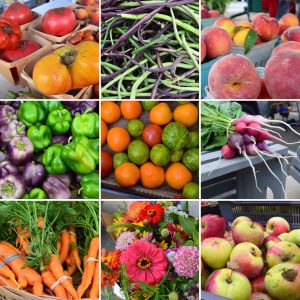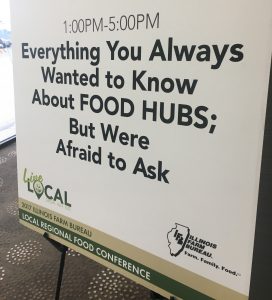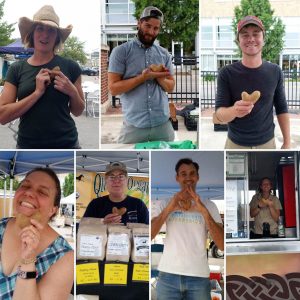Now that Market season has wrapped up, it’s time for the annual barrage of “So what do you do with yourself now that the season’s done?” The answer for all market managers is, of course, PLENTY. Analyzing the last season and planning, fundraising, getting ready for the next. But my work here at The Land Connection is more than the Market. I also work on creating new opportunities and sales outlets for local farmers, and increased access to local food for our whole community.

My primary project right now is a Local Food Promotion Program planning project, where I’m working with a team of local farmers, chefs, and business experts to examine the possibility of building an aggregation and distribution network on the local food infrastructure that already exists in Champaign-Urbana, helping find ways to connect local institutions and restaurants with local farmers to get more local food into the system. We know the demand is out there, people want to eat local, and the ones who sell food want to capitalize on that market. What we want to do is make it easier to connect these different players, to ensure integrity on the local food scene.
In the early stages of this project, we often used that wordy mouthful of a phrase, aggregation and distibution network, rather than its more common synonym: food hub. Why, you might ask? Because food hub seems to have become a term that elicits eyerolls or heads shaking with doubt when it comes to the local food players in the area. Despite the success of Illinois hubs like Legacy of the Land, many big ideas for Illinois food hubs have burst on to the scene, only to fizzle out, usually thwarted by the costs of maintaining a reliable distribution system. Two years ago, I attended a workshop highlighting area online ordering and food hub projects. We heard so many innovative ideas for bringing local product together and getting into restaurants, grocery stores, and institutions, but almost none of the tales had a happy ending.

So imagine my surprise last Monday at the Illinois Farm Bureau Local Regional Food Conference session on food hubs when Ag Economist James Barham, from USDA Rural Development compared the success rates of food hubs to your average small business. From 2005-2017 the success rate for small businesses was just over 50%. And for food hubs: 88%. That didn’t sound right after all I’d heard, but we spent the afternoon learning about the wide variety of food hub successes around the country.Maybe I shoudl back up and actually define what I mean by food hub. It’s basically a mission-driven approach to food distribution: a network that serves as an intermediary between local farmers and buyers. Small farms usually don’t have the time or manpower to market their products to all the potential buyers in the area, let alone to take orders and facilitate deliveries on a schedule compatible with restaurants’, supermarkets’, schools’ or hospitals’ needs. Some food hubs may pull produce (or meat, dairy, honey, value-added products, etc.) together to form a large multi-farm CSA (Community Supported Agriculture) system. Others offer commercial kitchen space for small-scale food producers to use local ingredients to make value-added products, such as jams, salsas, baked goods, you name it. Others work strictly wholesale, taking orders from restaurants, schools, or stores, and delivering local produce to them.
I always enjoy talking about food hubs with people who have never heard of them, because for a few brief moments after I describe one they think I am BRILLIANT (but then I have to fess up and admit that I didn’t actually come up with the concept). But trying to pull one together is a whole ‘nother story. We’ve had quite a few strong ideas over the past months on how to play to the strengths and demands of this particular community in order to build a network that will help increase sales for our local farmers, get fresher food to people who need it, and reduce food waste. Over the coming months I’ll elaborate on some of our plans and the challenges we run into, but for now I am at least feeling relieved that food hub might not necessarily be the harbinger of doom we’ve all been led to believe. With a clear vision of who we want to help, a strong commitment to our local farmers, and a path to build on our existing markets, co-ops, and institutions, I believe we can build an economy of collaboration that strengthens our food system in Champaign-Urbana over the years to come.



